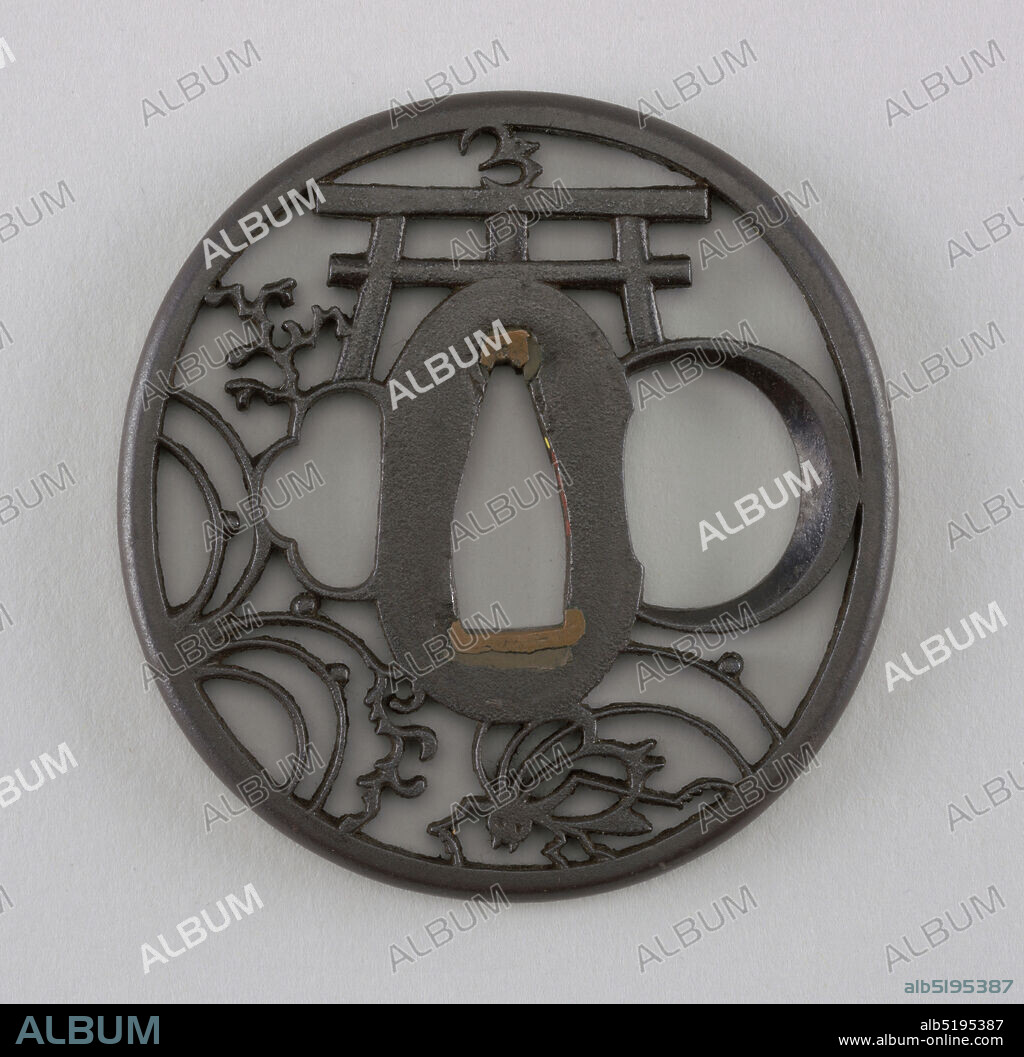alb5195387
Tsuba, Iron, shakudo (a soft copper and gold alloy), Probably Akaska school of Edo. This iron tsuba is naga maru gata (round) in shape, and is crafted in the ji sukashi openwork style, with a positive design showing mika tsuki, korogi, ran and torii (crescent moon, cricket, orchid and shrine gate), possibly making an allusion to a poem. At the center is a wide nakago-ana, an opening through which the sword passes, with sekigane (plugs added to fit the tsuba to a sword) made of shakudo (a soft copper and gold alloy). Surrounding this is the seppadai, a flat oval area that has a migaki ji (smooth) surface finish. On either side are ryo-hitsu, openings for the kozuka (utility knife) and the kogai (skewer tool). At right is sashi ura, the side which faces the blade, whose opening takes the negative form of a moon. Opposite is the sashi omote side, which faces the sword hilt. Its tri-lobed opening is of the suhama type, and symbolically represents the coastline of Horai, the holy island of the Immortals. The rim of the tsuba is round, or maru-mimi., Japan, 19th century, metalwork, Decorative Arts, Tsuba.

|
Añadir a otro lightbox |
|
Añadir a otro lightbox |



¿Ya tienes cuenta? Iniciar sesión
¿No tienes cuenta? Regístrate
Compra esta imagen.
Selecciona el uso:

Descripción:
Ver traducción automática
Tsuba, Iron, shakudo (a soft copper and gold alloy), Probably Akaska school of Edo. This iron tsuba is naga maru gata (round) in shape, and is crafted in the ji sukashi openwork style, with a positive design showing mika tsuki, korogi, ran and torii (crescent moon, cricket, orchid and shrine gate), possibly making an allusion to a poem. At the center is a wide nakago-ana, an opening through which the sword passes, with sekigane (plugs added to fit the tsuba to a sword) made of shakudo (a soft copper and gold alloy). Surrounding this is the seppadai, a flat oval area that has a migaki ji (smooth) surface finish. On either side are ryo-hitsu, openings for the kozuka (utility knife) and the kogai (skewer tool). At right is sashi ura, the side which faces the blade, whose opening takes the negative form of a moon. Opposite is the sashi omote side, which faces the sword hilt. Its tri-lobed opening is of the suhama type, and symbolically represents the coastline of Horai, the holy island of the Immortals. The rim of the tsuba is round, or maru-mimi., Japan, 19th century, metalwork, Decorative Arts, Tsuba
Crédito:
Album / quintlox
Autorizaciones:
Tamaño imagen:
5455 x 5351 px | 83.5 MB
Tamaño impresión:
46.2 x 45.3 cm | 18.2 x 17.8 in (300 dpi)
Palabras clave:
AJUSTE • APERTURA • APERTURAS • ARTES DECORATIVAS • ASPA • CARAS • CONTRARIO • COSTA • CRIQUET • EDO • ESPADA • FORMA • HIERRO • JAPON • LITORAL • LUNA EN CUARTO CRECIENTE • LUNA • METALISTERIA • OBRA DE METAL • ORQUIDEA • POEMA • PUÑO DE LA ESPADA • REDONDO • S. XIX • SHAKUDO • SHAPE • SIGLO XIX • TSUBA
 Pinterest
Pinterest Twitter
Twitter Facebook
Facebook Copiar enlace
Copiar enlace Email
Email
